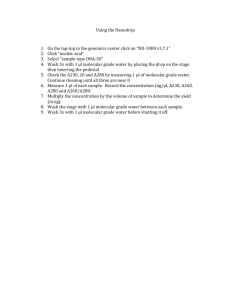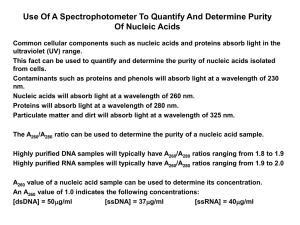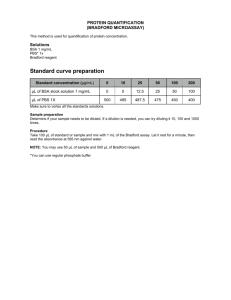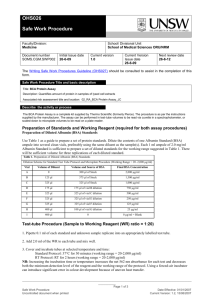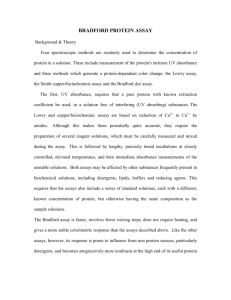Protein Analysis-Determination of Protein
advertisement
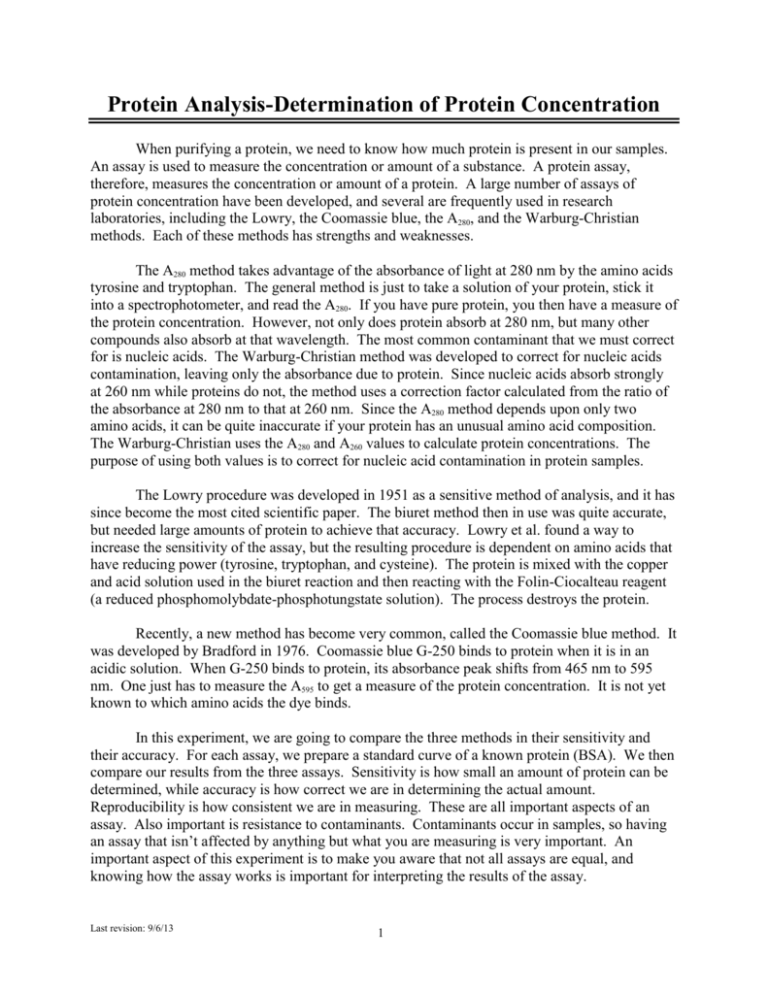
Protein Analysis-Determination of Protein Concentration When purifying a protein, we need to know how much protein is present in our samples. An assay is used to measure the concentration or amount of a substance. A protein assay, therefore, measures the concentration or amount of a protein. A large number of assays of protein concentration have been developed, and several are frequently used in research laboratories, including the Lowry, the Coomassie blue, the A280, and the Warburg-Christian methods. Each of these methods has strengths and weaknesses. The A280 method takes advantage of the absorbance of light at 280 nm by the amino acids tyrosine and tryptophan. The general method is just to take a solution of your protein, stick it into a spectrophotometer, and read the A280. If you have pure protein, you then have a measure of the protein concentration. However, not only does protein absorb at 280 nm, but many other compounds also absorb at that wavelength. The most common contaminant that we must correct for is nucleic acids. The Warburg-Christian method was developed to correct for nucleic acids contamination, leaving only the absorbance due to protein. Since nucleic acids absorb strongly at 260 nm while proteins do not, the method uses a correction factor calculated from the ratio of the absorbance at 280 nm to that at 260 nm. Since the A280 method depends upon only two amino acids, it can be quite inaccurate if your protein has an unusual amino acid composition. The Warburg-Christian uses the A280 and A260 values to calculate protein concentrations. The purpose of using both values is to correct for nucleic acid contamination in protein samples. The Lowry procedure was developed in 1951 as a sensitive method of analysis, and it has since become the most cited scientific paper. The biuret method then in use was quite accurate, but needed large amounts of protein to achieve that accuracy. Lowry et al. found a way to increase the sensitivity of the assay, but the resulting procedure is dependent on amino acids that have reducing power (tyrosine, tryptophan, and cysteine). The protein is mixed with the copper and acid solution used in the biuret reaction and then reacting with the Folin-Ciocalteau reagent (a reduced phosphomolybdate-phosphotungstate solution). The process destroys the protein. Recently, a new method has become very common, called the Coomassie blue method. It was developed by Bradford in 1976. Coomassie blue G-250 binds to protein when it is in an acidic solution. When G-250 binds to protein, its absorbance peak shifts from 465 nm to 595 nm. One just has to measure the A595 to get a measure of the protein concentration. It is not yet known to which amino acids the dye binds. In this experiment, we are going to compare the three methods in their sensitivity and their accuracy. For each assay, we prepare a standard curve of a known protein (BSA). We then compare our results from the three assays. Sensitivity is how small an amount of protein can be determined, while accuracy is how correct we are in determining the actual amount. Reproducibility is how consistent we are in measuring. These are all important aspects of an assay. Also important is resistance to contaminants. Contaminants occur in samples, so having an assay that isn’t affected by anything but what you are measuring is very important. An important aspect of this experiment is to make you aware that not all assays are equal, and knowing how the assay works is important for interpreting the results of the assay. Last revision: 9/6/13 1 Materials Spectrophotometers Curvettes Coomassie blue solution: Bio-Rad Dye Reagent Concentrate or Sigma Bradford Reagent Bovine Serum Albumin (BSA): 2.0 mg/ml (stock) Ovalbumin (stock, unknown concentration) Lysozyme (stock, unknown concentration) Methods For each of the three sets of assays, we want to prepare a BSA standard curve, and dilutions of Ovalbumin and Lysozyme. (9 samples in all for each assay). We will calculate the protein concentration of Ovalbumin and Lysozyme for each assay (compared to BSA), and calculate the extinction coefficient for BSA for each assay. Note that the stock concentration of BSA is 2.0 mg/ml. Do the parts in any order. To relieve pressure on the spectrophotometers, some of the class should do part A first, and some should perform part B first. Rotate through the procedures. A. A280 and Warburg-Christian Methods: For the samples described below, prepare 0.5 ml final volumes in microfuge tubes and read the A260 and A280. I. Protein Concentration and Sensitivity: Prepare a standard curve by preparing solutions of BSA at 0, 0.02, 0.06, 0.15, 0.3, 0.6, and 1.0 mg/ml (a total of seven different tubes). Each sample should have a final volume of 0.5 ml, with varying amounts of the stock BSA. For the other two proteins (Ovalbumin and Lysozyme), prepare samples by using 0.1 ml of the protein and 0.4 ml water for each (one of each, for a total of two tubes). You are trying to determine the concentration of these two proteins. II. Procedure: Read the absorbance at 260 and 280 nm (UV) for each of the samples, using the sample without BSA as the blank. 2 B. Coomassie Blue (Bio-Rad Microassay or Sigma Bradford): I. Protein Concentration and Sensitivity: Prepare a standard curve by preparing solutions of 0, 1, 2, 4, 6, 8, and 10 g/ml of BSA. Each sample should have 2 ml final volume, with varying amounts of the stock BSA. For the other two proteins (Ovalbumin and Lysozyme), prepare two samples (one for each protein) by using 3 l of the appropriate protein and then diluting them to a final volume of 2.0 ml with H2O. You are trying to determine the concentration of these two proteins. II. Procedure: Add 0.5 ml of the Dye Reagent concentrate to all nine samples. Vigorously mix the samples by vortexing them for 5 seconds. Let them sit for at least 5 minutes to let the color form, but not longer than 60 minutes. Read the A595 (visible) for each of the samples. Use the sample without protein as the blank. Lab Questions NOTE: Calculate protein concentrations in mg/ml! Plot the concentration of BSA (on the x-axis) vs. Absorbance (y-axis) for parts A and B (standard curves). From the curves and the known concentration of BSA, calculate the extinction coefficients for BSA for each assay. The extinction coefficient is a measure of how much light a sample absorbs, and is equivalent to the slope of the plot (keep the units of the axes in mind). Note that for part A, only plot the A280, and not the A260 or Warburg-Christian values. Which assay is the most sensitive? Why? Be sure that you took into account the correct dilutions of your samples. For the plot of part A, compare your results to the known extinction coefficient of BSA. A 1 mg/ml solution of BSA has an absorbance of 0.58. Also use the Warburg-Christian values (see the Appendix for these values) to determine the BSA concentrations. If the calculated absorbance ratio is off the scale of the chart, use the nearest value at the end of the scale. Calculate the concentrations of the stock Ovalbumin and Lysozyme for each of the assays, using the same extinction coefficients as calculated for BSA in the plots, or by using the Warburg-Christian table. You therefore have three different values for each. Explain how you calculated the results and be sure to take into account your dilutions. If Last revision: 9/6/13 3 the concentrations that you determine are greater than 10-fold off of each other, you probably made a calculation error regarding dilutions. From your data and analysis, what do you believe is the “true” concentration of Ovalbumin and Lysozyme? Note that you will have three different analyses for concentration that may or may not agree. Which assay is most accurate? Why? Appendix Warburg-Christian Method: The purpose of the Warburg-Christian method is to remove the effects of contaminating nucleic acids from the absorbance at 280 nm. The A260 and A280 are measured. If the absorbance is above 1.5, it should be diluted. The ratio of these two values is determined (the A280/A260), and a correction factor is determined from the table below. The concentration of protein is then: (A280) (correction factor) = mg/ml protein A280/A260 1.75 1.63 1.52 1.40 1.36 1.30 1.25 1.16 1.09 1.03 0.98 0.94 0.87 Correction factor 1.12 1.08 1.05 1.02 0.99 0.97 0.94 0.90 0.85 0.81 0.78 0.74 0.68 Nucleic Acid (in %) 0 0.25 0.50 0.75 1.00 1.25 1.50 2.00 3.00 3.50 3.50 4.00 5.00 A280/A260 0.85 0.82 0.80 0.78 0.77 0.75 0.73 0.71 0.67 0.64 0.62 0.60 4 Correction factor 0.66 0.63 0.61 0.59 0.57 0.55 0.51 0.48 0.42 0.38 0.32 0.29 Nucleic Acid (in %) 5.50 6.00 6.50 7.00 7.50 8.00 9.00 10.00 12.00 14.00 17.00 20.00

